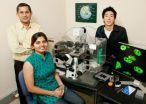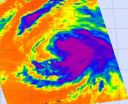(Press-News.org) University of California, Berkeley, and Yale University scientists have recreated the tremendous pressures and high temperatures deep in the Earth to resolve a long-standing puzzle: why some seismic waves travel faster than others through the boundary between the solid mantle and fluid outer core.
Below the earth's crust stretches an approximately 1,800-mile-thick mantle composed mostly of a mineral called magnesium silicate perovskite (MgSiO3). Below this depth, the pressures are so high that perovskite is compressed into a phase known as post-perovskite, which comprises a layer 125 miles thick at the core-mantle boundary. Below that lies the earth's iron-nickel core.
Understanding the physics of post-perovskite, and therefore the physics of the core-mantle boundary, has proven tough because of the difficulty of recreating the extreme pressure and temperature at such depths.
The researchers, led by Yale post-doctoral fellow Lowell Miyagi, a former UC Berkeley graduate student, used a diamond-anvil cell to compress an MgSiO3 glass to nearly 1.4 million times atmospheric pressure and heated it to 3,500 Kelvin (more than 3,000 degrees Celsius, or nearly 6,000 degrees Fahrenheit) to create a tiny rock of post-perovskite. They then further compressed this to 2 million times atmospheric pressure and zapped the substance with an intense X-ray beam from the Advanced Light Source (ALS) at Lawrence Berkeley National Laboratory to obtain a diffraction picture that reveals the deformation behavior of post-perovskite.
They found that the orientation of post-perovskite's crystals in the deformed rock allowed some seismic waves – those polarized parallel to the core-mantle boundary – to travel faster than those polarized perpendicular to it. This anisotropic structure may explain the observations of seismologists using seismic waves to probe the earth's interior.
"For the first time, we can use mineral physics with diamond-anvil cells at the ALS to get information about how this mineral, post-perovskite, performs under intense pressure," said co-author Hans-Rudolf Wenk, a Professor of the Graduate School in UC Berkeley's Department of Earth and Planetary Science and Miyagi's Ph.D. thesis advisor. "People had suggested this as an explanation for the anisotropy, but now we have experimental evidence."
"Understanding how post-perovskite behaves is a good start to understanding what's happening near the mantle's lower reaches," Miyagi said. "We can now begin to interpret flow patterns in this deep layer in the earth."
The study, which appears in the Sept. 24 issue of the journal Science, has important implications for understanding how the earth's internal heating and cooling processes work.
"This will give seismologists confidence in their models by matching what these observations predict with the seismic data they get," said coauthor Waruntorn "Jane" Kanitpanyacharoen, a UC Berkeley graduate student.
Post-perovskite was first recognized as a high-pressure phase in the mantle in 2004, and subsequent experiments in diamond-anvil cells have produced the mineral. Wenk and his colleagues in 2007 conducted experiments that they thought had determined the deformation behavior of post-perovskite, but which now appear to have been related to the phase transformation to post-perovskite. This transition takes place at about 1,300,000 times atmospheric pressure (127 gigaPascals) and 2,500 Kelvin (4,000 degrees Fahrenheit).
The current experiment showed that post-perovskite's crystal structure is deformed by pressure into a more elongated shape. Because seismic waves travel faster in the stretched direction, this matches the observed difference in velocity between seismic waves polarized horizontally and vertically traveling through the post-perovskite zone above the earth's core.
If scientists can gain a better understanding of the core-mantle boundary's behavior, it will give them clues as to how Earth's internal convection works there, where cool tectonic plates descend from the ocean floor through the mantle eventually nearing the dense, liquid-iron outer core, heat up, and begin moving upward again in a repeated cycle that mixes material and heat through the mantle.
INFORMATION:
Other authors of the paper include UC Berkeley researcher Pamela Kaercher and Kanani K. M. Lee, assistant professor of geology and geophysics at Yale.
The work was funded by the National Science Foundation, with support for the ALS from the U.S. Department of Energy.
High pressure experiments reproduce mineral structures 1,800 miles deep
Crystal structure of post-perovskite explains anisotropic seismic wave propagation
2010-09-24
ELSE PRESS RELEASES FROM THIS DATE:
Cancer-associated long non-coding RNA regulates pre-mRNA splicing
2010-09-24
CHAMPAIGN, Ill. — Researchers report this month that MALAT1, a long non-coding RNA that is implicated in certain cancers, regulates pre-mRNA splicing – a critical step in the earliest stage of protein production. Their study appears in the journal Molecular Cell.
Nearly 5 percent of the human genome codes for proteins, and scientists are only beginning to understand the role of the rest of the "non-coding" genome. Among the least studied non-coding genes – which are transcribed from DNA to RNA but generally are not translated into proteins – are the long non-coding RNAs ...
GOES-13 sees tropical depression 15 form in the south-central Caribbean Sea
2010-09-24
The fifteenth tropical depression of the Atlantic Ocean season has formed in the south-central Caribbean Sea, and the GOES-13 satellite captured its swirling mass of clouds and showers in a visible image today. Watches and warnings are already up for Central America.
At 2 p.m. EDT today, Sept. 23, Tropical Depression 15 had maximum sustained winds near 35 mph. It was located about 485 miles east of Puerto Cabezas, Nicaragua, near 13.9 North and 76.2 West. It was moving west at 15 mph, and had a minimum central pressure of 1007 millibars.
The government of Nicaragua ...
NASA sees important cloud-top temperatures as Tropical Storm Malakas heads for Iwo To
2010-09-24
NASA's Aqua satellite has peered into the cloud tops of Tropical Storm Malakas and derived just how cold they really are, giving an indication to forecasters of the strength of the storm.
The Atmospheric Infrared Sounder instrument, known as AIRS has the ability to determine cloud top and sea surface temperatures from its position in space aboard NASA's Aqua satellite. Cloud top temperatures help forecasters know if a storm is powering up or powering down.
When cloud top temperatures get colder it means that they're getting higher into the atmosphere which means the ...
NASA satellites help see ups and downs ahead for Depression Lisa
2010-09-24
Tropical Depression Lisa has had a struggle, and it appears that she's in for more of the same.
Infrared satellite imagery from the Atmospheric Infrared Sounder (AIRS) instrument on NASA's Aqua satellite shows that the convection (rapidly rising air that forms thunderstorms that make up a tropical cyclone) is increasing in Lisa. The convection is becoming a little better organized and stronger which is will make for some heavy rainfall over the northwestern Cape Verde Islands. It's also an indication that she may be strengthening back into a tropical storm today.
That ...
Team of researchers finds possible new genetic risk for Alzheimer's disease
2010-09-24
Researchers have identified a gene that appears to increase a person's risk of developing late-onset Alzheimer's disease, the most common form of the disease. The gene, abbreviated as MTHFD1L, is on chromosome six, and was identified in a genome-wide association study. Details are published September 23 in the journal PLoS Genetics.
The collaborative team of researchers was led by Margaret A. Pericak-Vance, PhD, Director of the John P. Hussman Institute for Human Genomics at the University of Miami Miller School of Medicine; Joseph D. Buxbaum, PhD, Department of Psychiatry, ...
Earth: Fixing Pakistan's water woes
2010-09-24
Pakistan is facing tremendous water issues. This summer's flooding has left millions of people without homes and without access to clean drinking water. But water issues - both quantity and quality - are not new to this strategically important country. Waterborne diseases account for 30 percent of all deaths in Pakistan, and kill some 250,000 children each year. Per capita water availability in Pakistan is less than one-ninth of what it is in the U.S. And what's more, researchers say if Pakistan doesn't manage its water resources differently, it's going to actually run ...
Robotic arm's big flaw: Patients say it's 'too easy'
2010-09-24
One touch directs a robotic arm to grab objects in a new computer program designed to give people in wheelchairs more independence.
University of Central Florida researchers thought the ease of the using the program's automatic mode would be a huge hit. But they were wrong – many participants in a pilot study didn't like it because it was "too easy."
Most participants preferred the manual mode, which requires them to think several steps ahead and either physically type in instructions or verbally direct the arm with a series of precise commands. They favored the manual ...
Black motorcyclists -- even in helmets -- more likely to die in crashes
2010-09-24
African-American victims of motorcycle crashes were 1.5 times more likely to die from their injuries than similarly injured whites, even though many more of the African-American victims were wearing helmets at the time of injury, according to a new study by Johns Hopkins researchers.
Results of the research revealing these racial disparities, published in the August issue of the American Journal of Surgery, suggest that injury-prevention programs — like state laws mandating the use of motorcycle helmets — may not be sufficient to protect all riders equally.
"For reasons ...
Withering well can improve fertility
2010-09-24
Contrary to a thousand face cream adverts, the secret of fertility might not be eternal youth. Research by the ecologist Dr. Carlos Herrera, a Professor of Research at the Consejo Superior de Investigaciones Científicas in Seville, Spain has shown that the withering action of flowers may have evolved to protect their seeds. His research is published in the October 2010 issue of the Annals of Botany (http://dx.doi.org/10.1093/aob/mcq160).
Prof. Herrera said: "No one has paid much attention to the corollas, collections of petals on a flower, when they shrivel. Their job ...
One of a Kind Comic Art Painting Exclusively for Sale on Sketch Maven for a Limited Time
2010-09-24
Comic collectors and art aficionados have the opportunity to acquire a unique piece of cartoon art history. This week, Sketch Maven is offering a tremendous piece of cartoon artwork featuring the characters of Moon Mullins, one of the longest running comic strips in American history.
"This is beautiful artwork by Ferd and Tom Johnson, measuring over six feet tall and nearly four feet wide. I haven't seen anything like it before," comments Mike Todasco, founder of Sketch Maven, the World's Greatest Original Comic Art Marketplace. "We are fortunate to have this artwork ...
LAST 30 PRESS RELEASES:
The impact of family dynamics on eating behaviour – how going home for Christmas can change how you eat
Tracing the quick synthesis of an industrially important catalyst
New software sheds light on cancer’s hidden genetic networks
UT Health San Antonio awarded $3 million in CPRIT grants to bolster cancer research and prevention efforts in South Texas
Third symposium spotlights global challenge of new contaminants in China’s fight against pollution
From straw to soil harmony: International team reveals how biochar supercharges carbon-smart farming
Myeloma: How AI is redrawing the map of cancer care
Manhattan E. Charurat, Ph.D., MHS invested as the Homer and Martha Gudelsky Distinguished Professor in Medicine at the University of Maryland School of Medicine
Insilico Medicine’s Pharma.AI Q4 Winter Launch Recap: Revolutionizing drug discovery with cutting-edge AI innovations, accelerating the path to pharmaceutical superintelligence
Nanoplastics have diet-dependent impacts on digestive system health
Brain neuron death occurs throughout life and increases with age, a natural human protein drug may halt neuron death in Alzheimer’s disease
SPIE and CLP announce the recipients of the 2025 Advanced Photonics Young Innovator Award
Lessons from the Caldor Fire’s Christmas Valley ‘Miracle’
Ant societies rose by trading individual protection for collective power
Research reveals how ancient viral DNA shapes early embryonic development
A molecular gatekeeper that controls protein synthesis
New ‘cloaking device’ concept to shield sensitive tech from magnetic fields
Researchers show impact of mountain building and climate change on alpine biodiversity
Study models the transition from Neanderthals to modern humans in Europe
University of Phoenix College of Doctoral Studies releases white paper on AI-driven skilling to reduce burnout and restore worker autonomy
AIs fail at the game of visual “telephone”
The levers for a sustainable food system
Potential changes in US homelessness by ending federal support for housing first programs
Vulnerability of large language models to prompt injection when providing medical advice
Researchers develop new system for high-energy-density, long-life, multi-electron transfer bromine-based flow batteries
Ending federal support for housing first programs could increase U.S. homelessness by 5% in one year, new JAMA study finds
New research uncovers molecular ‘safety switch’ shielding cancers from immune attack
Bacteria resisting viral infection can still sink carbon to ocean floor
Younger biological age may increase depression risk in older women during COVID-19
Bharat Innovates 2026 National Basecamp Showcases India’s Most Promising Deep-Tech Ventures
[Press-News.org] High pressure experiments reproduce mineral structures 1,800 miles deepCrystal structure of post-perovskite explains anisotropic seismic wave propagation





